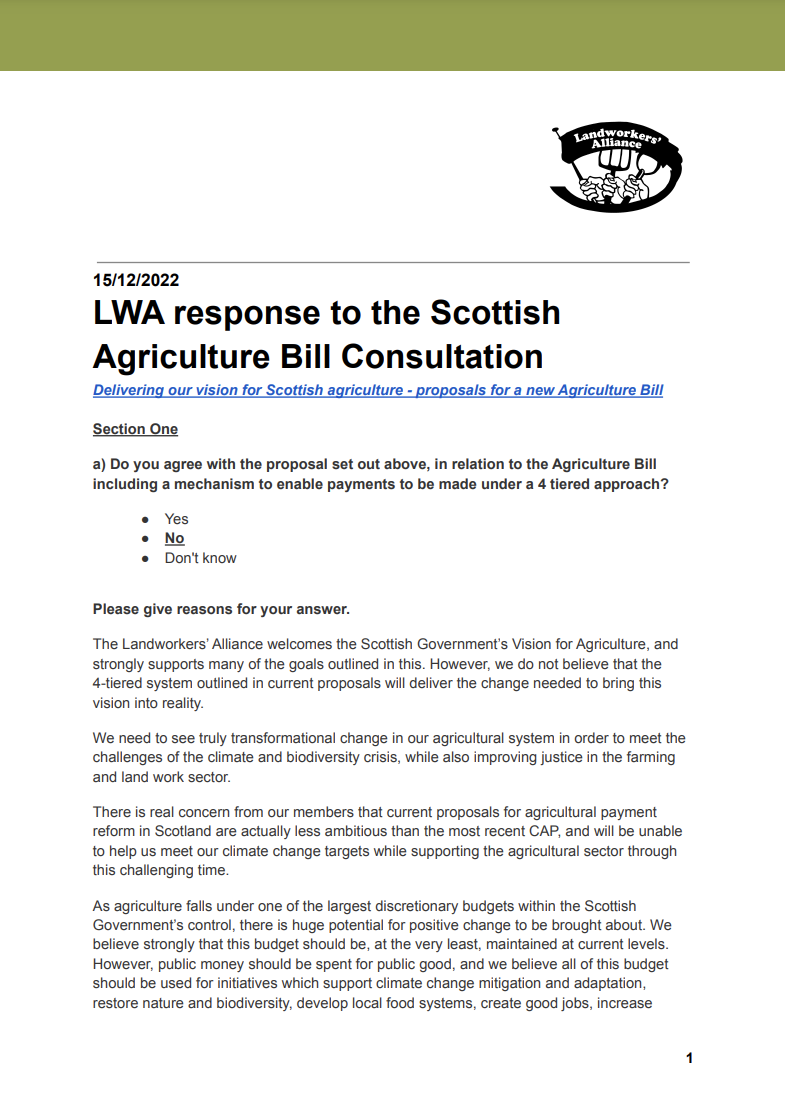by Tara Wight, LWA Scotland Policy and Campaigns Coordinator
At the end of September, the Scottish government released their first draft of the long-anticipated Agriculture and Rural Communities Bill, which will lay the legal groundwork for replacing the current EU-legacy agricultural payments system. With over £3.5 billion of public money to be spent on agriculture and rural development over the next five years, it’s a pretty important piece of legislation. It matters to everyone where this money goes, and what sort of food, farming and land use system is supported in Scotland.
So, what does this new bill tell us about the future of agricultural support in Scotland? Unfortunately, not much at this stage. It’s a piece of ‘framework’ legislation, which means it’s more about giving government ministers the power to introduce a new agricultural and rural payments system, rather than covering the details of where the money will go. We can expect more detail to be laid out in secondary legislation over the coming year.
There are, however, some promising signs in this first draft, including clearly stated objectives for agricultural policy to support sustainable and regenerative practices, production of high quality food, nature restoration and climate mitigation, and thriving rural communities. There’s also a commitment to publishing clear guidance about what ‘sustainable and regenerative agriculture’ means, which will hopefully make it possible to hold the government accountable to these objectives, and ensure they’re not just ‘nice words’.
Disappointingly though, it seems that the unjust and ineffective area-based payments system is set to continue under the new legislation. Under an area-based payments system, farmers and land managers receive funding per hectare of land that they farm, meaning the largest landowners receive the bulk of the available funding, and the small- to medium-scale producers who need it most receive little to nothing. Not only is this deeply unfair, but subsidising the wealthiest landowners is also a highly inefficient use of public money. In the new Bill, the first tier of funding is set to be a per-hectare direct payment, much like the ineffective support system we’ve had for the past couple of decades.
The Bill does give ministers the power to cap or taper the amount of financial support farms can receive above a certain hectarage if they want to, but at the moment there is no obligation for them to do this. In order to effectively tackle the injustice of the area-based payments system, we need to see a mandatory redistributive payment included in the primary legislation to support smaller scale producers. This would mean extra funding was available for the first few hectares of land farmed, with less money awarded per hectare above a certain threshold. We explored this idea more thoroughly in our webinar in June.
“Pushing for redistribution of direct payments will be a key priority for the LWA as the Agriculture Bill makes its way through parliament”
Redistributive payments are already mandatory in the EU, and given the Scottish government’s stated objective of remaining aligned with the EU on agricultural policy, it would make sense for redistributive payments to be mandatory here as well. Pushing for redistribution of direct payments will be a key priority for the LWA as the Agriculture ill makes its way through parliament.
The exact division of funding between different tiers of support is not laid out in the bill itself, however, in the accompanying financial memorandum it is stated that the government is intending to keep a similar proportion of funding in direct (that is, area-based) payments as in previous legislation. This amounts to more than 70% of the budget, with only a small amount left to support other schemes such as organic conversion, nature restoration, small-holders, new entrants and advisory services – all of which will be essential for Scotland’s agricultural transition. The LWA will be calling for a larger proportion of the money to be allocated to these sorts of schemes, so that future agricultural support focuses on enabling a just transition rather than subsidising large-scale land ownership.
In particular, we are calling for funding to be dedicated to specific schemes to support small-scale horticulture and new entrants to agriculture. Previous agricultural payments systems have offered nothing to small-scale fruit and vegetable producers, even though market gardens are an extremely efficient use of land for food production and could support government objectives around good food and health. We will be campaigning for fruit and veg production to be supported under every tier of the new Agriculture Bill, including the introduction of a dedicated Horticulture Support Scheme.
With the average age of farmers well over 60 in Scotland and land prices rocketing, supporting new entrants to the sector should be one of the government’s top priorities for the new payments package. We are calling for a holistic approach to new entrant support, including training, assistance with accessing land, and capital funds available for those who want to get into sustainable food production in Scotland.
For more detail on the LWA’s key asks for the Scottish Agriculture Bill, see our response to the initial consultation.
Overall, is this new bill going to bring about the transformative change we need to see in our farming and land use system? It’s not looking terribly likely at the moment, but there is some scope within the current framework to develop a more ambitious approach through secondary legislation. Lots of campaigning will be needed over the coming months to help ensure the eventual new agricultural payments system actually meets the government’s promising objectives!

Please get in touch with tara.wight@landworkersalliance.org.uk if you would like to get involved with our campaign for a better Agriculture Bill.
Image credit: Lynbreck Croft, photo taken by Clem Sandison

